Summary: Equities are 2-5% higher so far in May, trying to add to their small gains from April and put behind a rough winter. This past week, small caps closed at a new all-time high (ATH) and NDX broke to a 7 week high near its March ATH. This is constructive for the broader market. But new uptrends are defined by persistent strength; it's time for large caps to reveal the true character of this market.
US equities fell slightly last week. SPX and DJIA lost about 0.5%. But May, so far, is tracking positive. Large caps are up 2.5%, tech stocks are up 4% and small caps are up more than 5%. The volatility index, VIX, has been crushed.

Recall, April ended with a minor gain after falling in both February and March. So, equities are making an attempt to reassert their prior uptrend after a rough winter.
We laid out our longer term perspectives in our last weekly update (here). In summary:
US equities have been in a consolidation phase for most of 2018. In the past, these consolidation periods have lasted a half year or longer - so this might continue into summer.
New highs are very likely to still lie ahead in 2018. This is still a bull market.
SPX reached its highest level since March this past week. It is 6% off its YTD low and also 6% from its YTD high. Objectively, it's still in a consolidation phase. The next big battle to the upside is at 2800, a level it has tried to breach just once since plunging through it February 1st.

A good start to the week ahead is important. Last week ended with two down closes, pushing SPX below its now flat 5-dma (green line above). The weekly pivot (2720) is also above Friday's close. Uptrends mostly remain above the weekly pivot. Momentum is also nearing 'oversold'; uptrends rarely stay oversold for long and spend most of their time overbought. So, the character of the market will probably be revealed early this week.
SPX also ended last week right on its rising 20-weekly MA (blue line). SPX has a strong tendency to trend higher above this moving average (and to be choppy and corrective below it). Closing this pre-holiday week at least flat is thus important, moving the weekly MACD closer to a positive cross (lower panel).
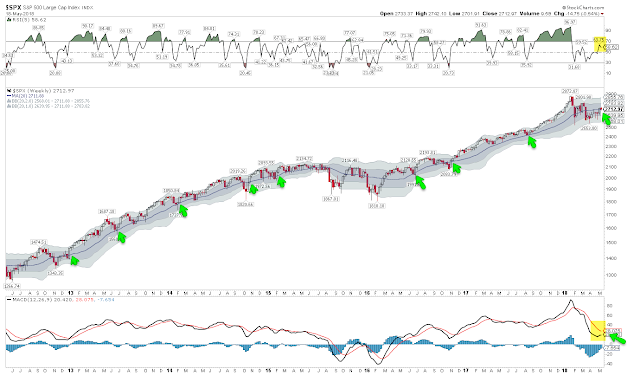
The action in the NDX is encouraging; it broke to a 7 week high this past week and made its first test of the March "Island Top" gap at 7020 (arrows). SPX typically follows NDX. Watch for NDX to stay above 6800 on weakness; below that and it reenters the hot mess from April and early May, a bad sign. A close above 7020 opens up a test of the March high and, more likely, new highs for both NDX and SPX.
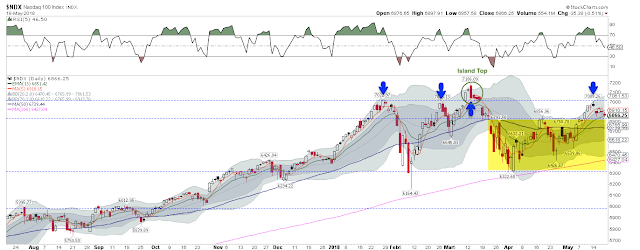
There is not much hidden strength at the sector level. Energy is at a YTD high and Technology is also close to being so, but the other sectors have not exceeded their pivot highs from the past 1-2 months.
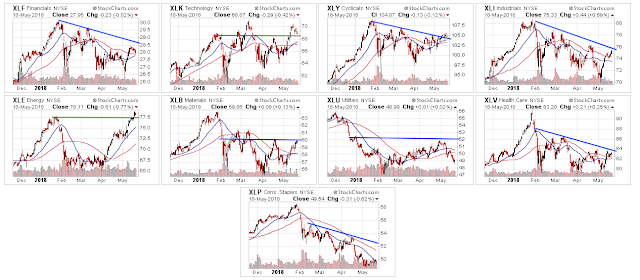
Small caps (RUT) broke out to a new all-time high this past week. That would seem to be a sign of strength for the broader market, as this index comprises 2000 companies. But it has, historically, meant little: the forward odds of SPX moving higher are neutral (from Quantifiable Edges, here).

That should not be surprising. RUT is a much smaller index than SPX. SPX represents about 76% of the total market capitalization of US equities. RUT is just 9%. The 6 largest components of the DJIA have a greater combined market capitalization than all 2000 components of the RUT. It's not clear why a small subset of stocks should be expected to provide more useful insight on the health of US equities than SPX itself. And, in fact, history suggests they do not.
Likewise, that the advance-decline line of the NYSE made a new high this past week has, historically, meant little to the forward returns for SPX. A month later, SPX was just as likely to be higher as lower. That's striking, as SPX is naturally higher in 60% of all months and 68% of all 3 month periods (from Dana Lyons, here).

This result should also not be surprising. Measuring the market's health by the advance-decline line suffers from a basic conceptual problem. If a lot of small stocks move up by one penny on low volume but slightly fewer large companies move down a dollar on high volume, the advance-decline line still moves higher. Or, if a large number of defensive stocks move up while "risk-on" cyclical stocks move down, the advance-decline line moves higher. Neither of these is a sign of market health.
Neither of these breadth studies are bearish. But investors expecting equities to move higher because of the strength in small caps or the advance-decline line are deceiving themselves. They provide no edge. Moreover, significant drops in 2010, 2011, 2015 and 2018 were directly proceeded by, for example, new highs in the advance-decline line.

The rise in equities since early April began with pessimism among investors. The 4-week AAII bull/bear spread was at a 7 month low, for example. That provided a nice tailwind to higher prices.
That's less true today. For example, speculators were a record net long in volatility in April: a bet that VIX would rise and equities drop. That has now mostly been unwound. "Smart money" hedgers are now back to neutral. That isn't bearish - there's plenty of room for their long position to expand while equities rise and volatility falls - but a big tailwind for equities has been tapped (from Sentiment Trader; click here).
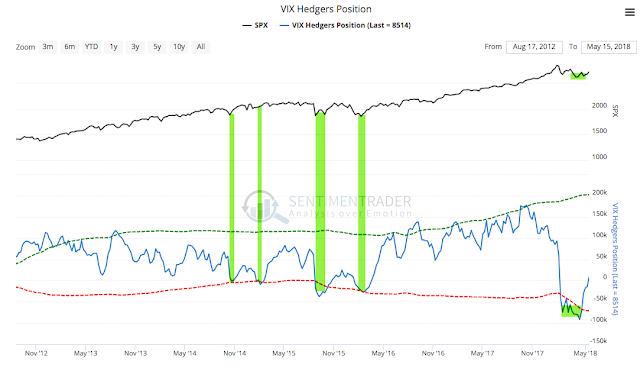
Over the longer term, a sentiment tailwind is probably present. Investors have mostly been sellers of domestic mutual funds and ETFs: fund flows have been negative in 6 of the last 9 quarters, including all of the past 3 quarters (red circle). This is similar to the period from 2009 to 2013, when investors were unsure of the new bull market, and it's in sharp contrast to the lead into the big equity peaks in 2000 and 2007 as well as the lesser peak in 2015 (blue circles; from JPM).
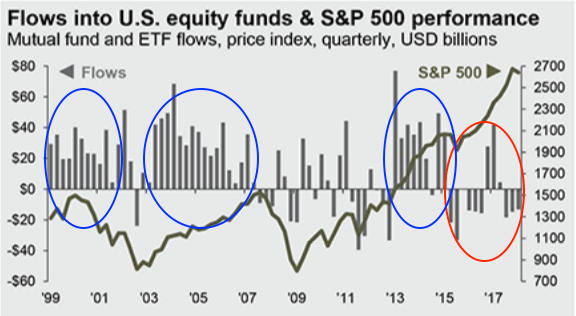
Macro data continues to point to expansion. April housing starts rose 11% yoy. Real retail sales rose 2.2% yoy. Unemployment claims fell to a new 49 year low this past week; those claims have historically troughed at least 6 months ahead of recession. A nice study from Tom McClellan (here) shows that unemployment will likely continue to fall with the continued rise in the University of Michigan Consumer Sentiment Index.

Why follow macro indicators when equity prices usually fall ahead of a recession? One reason is that at least a few macro indicators lead equity prices.
Take the yield curve (10-year minus 2-year UST yield), for example. In the past 40 years, the yield curve has "inverted" an average of 13 months before the SPX has peaked, which in turn has lead the next recession by an average of 4 months. Following macro helps distinguish between a scary equity drop that happens every year in a bull market and one that is likely to lead to a bear market (from JPM).
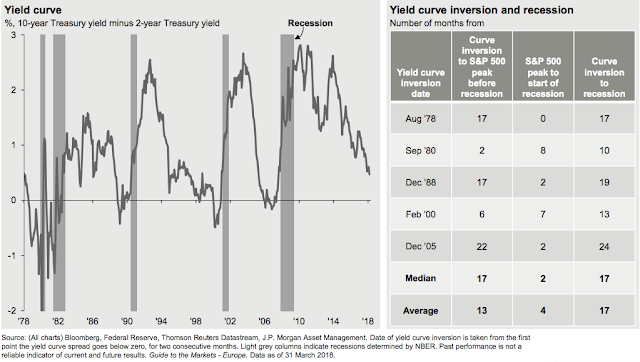
The week before the Memorial Day weekend is not especially strong from a seasonality standpoint (first chart, from Sentimentrader). However, the week after is; that week is also the last of May and the start of June, a period when equities tend to rise (second chart, from the Stock Almanac).
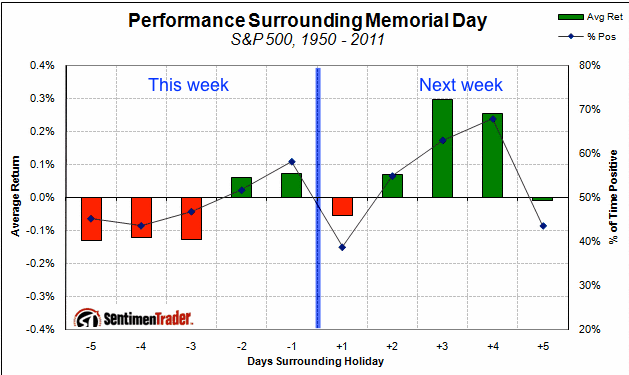
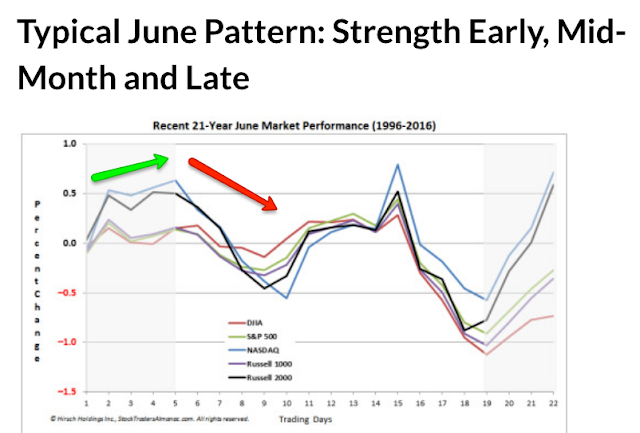
In summary, equities are 2-5% higher so far in May, trying to add to their small gains from April and put behind a rough winter. This past week, small caps closed at a new all-time high (ATH) and NDX broke to a 7 week high near its March ATH. This is constructive for the broader market. But new uptrends are defined by persistent strength; it's time for large caps to reveal the true character of this market.
On the upcoming calendar: FOMC minutes and new home sales on Wednesday; Durable Good on Friday; Memorial Day weekend; NFP on Friday June 1.
